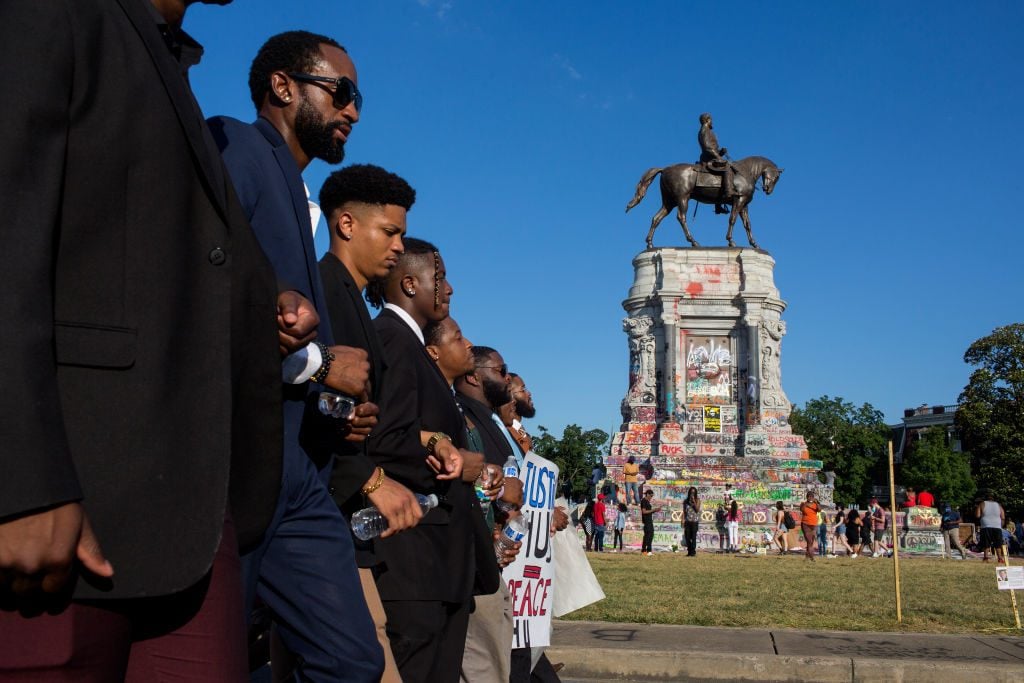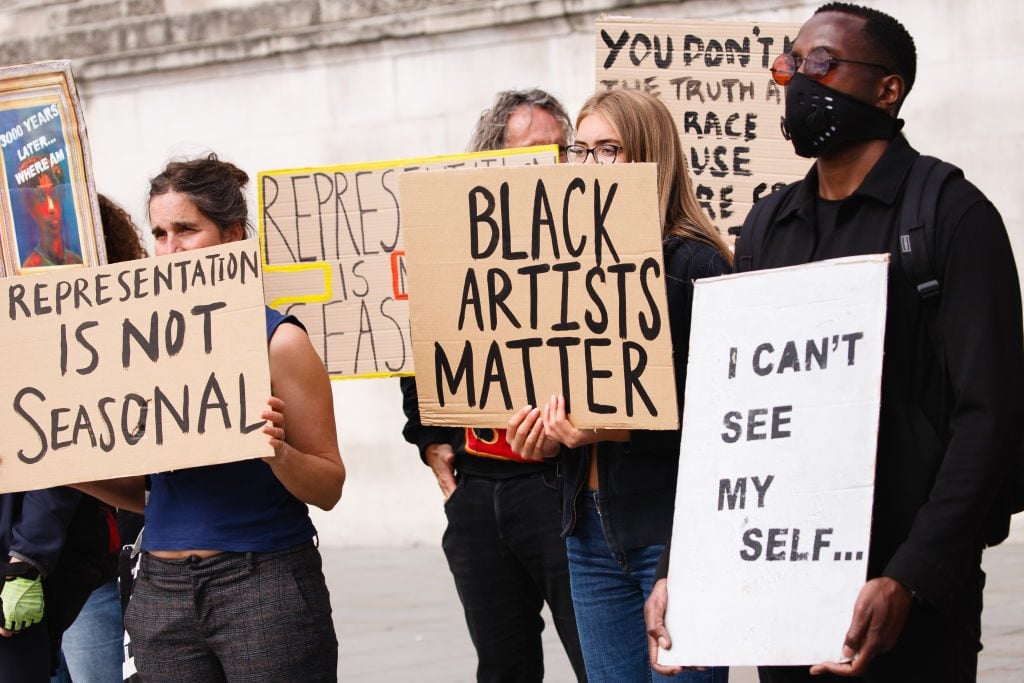Op-Ed
How Museums Could Reimagine Themselves in the Aftermath of the Black Lives Matter and Rhodes Must Fall Movements
The time has come for a radical and qualitative change in imagination, language, and culture.

The time has come for a radical and qualitative change in imagination, language, and culture.

Malgorzata Ludwisiak

“Something should stand while Rhodes falls,” said one of the passers-by witnessing a performance by the South African artist Sethembile Msezane in front of the University of Cape Town in 2015. The performance was unfolding on April 9, right next to a statue of the 19th-century imperialist Cecil Rhodes as it was being taken down following a widespread protest movement calling for its removal.
Msezane placed her own Black, female, artist’s body in place of the image of the white male colonizer and ruthless capitalist. The artist was dressed as a chapungu bird—a recurring theme of her dreams, and the national bird of Zimbabwe, sculptures of which had adorned ancient Great Zimbabwe, and were later looted during the colonial period. One of the stolen works was bought by Rhodes and is still housed at his estate, while others were restored to their original location once the country regained independence.
In a talk given two years after the Rhodes monument was removed, Msezane invited the public to take part in an exercise. “You’re a little [Black] girl of five years old,” she said. “Sitting in front of a mirror, you ask yourself, Do I exist? … Do I only exist when people speak to me?”
I obliged, and suddenly I felt goosebumps, as if I were an object amid other objects. It brought me back to her performance, and I understood how revolutionary is the change brought by a multiple substitution—of a Rhodes statue, for a Black woman, for a chapungu.

Black Lives Matter activists occupy the traffic circle underneath the statue of Confederate General Robert Lee on June 13, 2020 at Monument Avenue in Richmond, Virginia. Photo by Andrew Lichtenstein/Corbis via Getty Images.
Msezane’s powerful performance encompassed multi-layered, simultaneous gestures of displacing and replacing different images, of destroying and erecting a new monument. It also preceded, in a kind of prophetic way, the global events of the Black Lives Matter demonstrations of 2020, during which dozens of statues were beheaded or pulled down in the US and around the globe, murals were painted over and repainted, and state flags were redesigned.
Some monuments were replaced by new ones. In Philadelphia, a 20-year-old mural honoring former mayor Frank Rizzo, known for his racist and discriminatory politics, was painted over. In its place, a group of artists and community members started a series of monumental projections on the now-blank wall and featured members of local African American, Asian, and Mexican communities who worked at the local market. Still, many other gestures remain caught between remembering and forgetting, with empty plinths waiting to be pulled down or filled with new images and representations.
Confronted with one of the biggest cultural earthquakes in the Western world, with uprisings and beheadings reminiscent of the French Revolution, at first museums remained astonishingly silent, with the exception of timid gestures of solidarity like publishing Black artists’ works from their collections on their websites and on social media. It brought to mind philosopher Frantz Fanon’s writings on the anti-colonial struggle in Black Skin, White Masks, where he wrote of how Black intellectual power is absorbed when it conforms to the rigged systems established by white colonizers. Is this not a continuation of white efforts to neutralize a potential Black threat to the system, only this time it is white skin, and Black masks?
As soon as you remember that museums operate in the realm of images, representation, and historical politics, this helplessness starts to make some sense. An iconoclastic crisis affects museums’ fundamental core. In order to remain relevant, museums would have to change their very being, rather than only take quantitative and additive actions such as implementing a more diversified racial structure of staff, introducing more work by Black and brown artists as a part of acquisition policies, or including more suppressed “voices,” “narratives,” or “geographies,” in their programming.
Such proposals and practices, although very much needed, are all performed with the verb “to include”—include someone or something into the order that is “ours,” and make more room for them among our images, representations, and narratives. Such a focus on “inclusion” alone will not alter, and—paradoxically—might even reinforce the status quo. After all, isn’t the process of othering, followed by exoticization and commodification of differences another form of colonialism—a colonialism that is inverted or disguised behind the Black mask?
After some time, a few museums in the US have advanced on their commitments to Black Lives Matter, with some taking brave but controversial steps to deaccession works by white artists in order to acquire work by artists of color.

Black Lives Matter activists calling for equal representation for the works of black artists in British museums, galleries and national institutions. Photo by David Cliff/NurPhoto via Getty Images.
Still, museums have recently been the subject of distrust and fierce criticism from BLM activists, artists, and even museum professionals. Muralists have refused their artworks—created in response to George Floyd’s murder—from being displayed in museums, arguing that they would “die” there. Theoreticians and museum practitioners point to the broken foundation of colonialism that museums are built upon as the reason why they can never be unbiased, and instead remain, as curator Yesomi Umolu put it in an article for Artnet News, “exclusionary spaces for the privileged” that are “built for the betterment of Western subject and society at the expense of the other.”
The reason for this deep distrust seems to lay in the rootedness of both—museums and racism—in the Enlightenment and its ideas of history as progress. These ideas are richly represented in and by museums and their collections as well as in public spaces marked by monuments of people who made this “progressive” history happen. Can racism be truly dismantled without dismantling history and museums as we know them?
Theorist Homi Bhabha, in his foreword to Fanon’s Black Skin, White Masks, claims that “Black presence ruins the representative narrative of Western personhood.” Almost 30 years after Bhabha’s text, and more than 60 after Fanon’s, following the tearing down of the Rhodes’ statue, the Cameroonian philosopher Achille Mbembe calls for demythologizing history by thinking from outside of whiteness.
In another text published a year later, Mbembe states that at the very moment that “a slave” (le Nègre) would have entered the museum as we know it today, it would “cease to be a museum.” In other words: museums as monuments of whiteness and colonial history are built (as a premise) for a white subject. So Black presence in such a museum ruins—in philosophical and logical terms—the sense of its existence. Mbembe sees museums as spaces for neutralizing living forces. Instead, he says, it is necessary to establish an “anti-museum,” which would not be an institution but rather a symbol of an “other-place.”
Today, it is difficult to resist the impression that the time has come for a radical and qualitative change in imagination, language, and culture. In order to reinvent a museum that would be relevant to the current moment, could we imagine a museum that treats both these movements—Black Lives Matter and Rhodes Must Fall—as resources?
Could we imagine getting rid of entire collections and leaving exhibition halls empty? Could we forget the images we already know, and histories they represent? Could we imagine engaging local communities in decision-making processes? Could we imagine an entirely Black or Sami or Aboriginal collection on display? Could we imagine a community instead of a collection?
Removing or partially destroying monuments initiates the process of dismembering (white) history. Such exercises might lead us to redesign the relationship between identities and masks, remembering and forgetting, images and representations. We might also change our vocabularies to substitute the verb “to include” with other verbs: demythologize, dismember, displace, undo, and substitute. It is substitution that might eventually lead to unlearning, decolonizing, and forgetting.
Only then, might the conditions be created such that “no little black girl has to ever feel like she doesn’t exist” as Msezane emphasizes—after all, all representation is about existence.
Malgorzata Ludwisiak is a board member for CIMAM, the International Committee for Museums and Collections of Modern and Contemporary Art, an independent art critic and curator, museums’ advisor, academic teacher. Previously, she was director of the CCA in Warsaw (2014-19), and deputy director of Muzeum Sztuki in Lodz (2008-14).